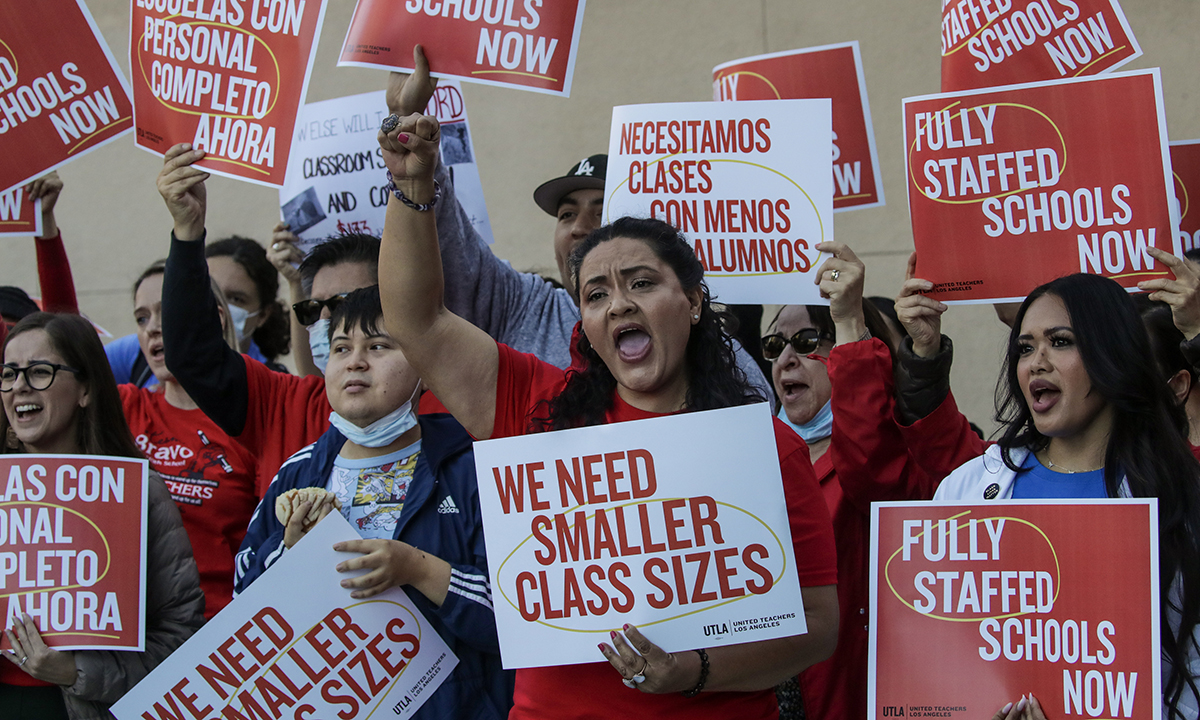PACs Get Attention, but Teachers Unions Still Dominate School Board Elections
Conservatives are backing 100 candidates in 4 states. In California alone, unions are supporting 287 — to the tune of at least $1.8 million

Get stories like these delivered straight to your inbox. Sign up for The 74 Newsletter
Florida Gov. Ron DeSantis created a stir last summer when he endorsed 30 candidates for local school boards in the state. It is highly unusual for a state-level politician to get involved in so many local races, especially nonpartisan ones. Nineteen won, and six more advanced to a runoff.
Conservative groups have joined in, providing funds and volunteers for more than 100 school board candidates in Florida, Texas, Virginia and Pennsylvania.
The national press has noticed, with the Associated Press, USA Today and NBC News running stories with alarming headlines like: “These PACS are funding ‘parents’ rights advocates’ running for local school board positions” and “Liberal parents are joining the school culture wars — but conservatives are way ahead.”
New political action committees supporting school board candidates are certainly newsworthy, but heavy teachers union involvement has been going on for years.
The national unions deny they have anything to do with school board elections. “In 12 years as president of AFT, I can count on two hands the ones we were seriously involved in,” Randi Weingarten, president of the American Federation of Teachers, told USA Today.
That’s only because of the way AFT and the National Education Association are structured. AFT has affiliates, which they help fund, in nine of the 10 largest school districts in the United States. NEA has a presence in every state, with 13,000 local affiliates in all. Those local and state affiliates are heavily involved in school board races.
How heavily involved? Up-to-date internal documentation from the California Teachers Association illustrates.
The union’s Association for Better Citizenship political action committee funds candidates for all state and legislative offices, but it also provides the bulk of campaign contributions for endorsed local school board candidates.
This November, the state union is funding 287 board candidates in 125 school districts — from Los Angeles, with 430,000 students, all the way down to Big Pine, which enrolls 155 kids — to the tune of more than $1.8 million.
That’s a lot of money from a single state affiliate. But there’s more. The union has a rule that limits its contributions to no more than 65% of the total campaign budget. In other words, if the state union is spending $1.8 million, its local affiliates must be adding a minimum of $970,000, and perhaps much more.
Naturally, the elections in the largest districts received the most money. The state union allocated $330,600 to Los Angeles Unified school board candidate Rocio Rivas. But even tiny campaigns saw outsized contributions. The union sent $1,500 to the American Bear Education Association for two school board candidates. That’s not much, but that district has only 750 students, and the local union has only 39 members.
Money can be decisive in any election, but it’s just one way that teachers unions can affect school board campaigns. For one thing, they can turn out volunteers and call on the expertise of the experienced staffers on the union payroll. Plus, some school board candidates are people they already know well as colleagues.
A 2018 study conducted by the National School Boards Association found that 24% of school board members surveyed were current or former members of a teachers union.
In his new report for the Manhattan Institute, Michael Hartney examined many other surveys that found similar percentages. He notes that about one in 10 school boards in California have educator majorities.
At the risk of stating the obvious, school boards are supposed to represent the public at large, not just school employees. Representing employees is the union’s job.
These advantages are difficult for opponents to overcome. Hartney looked at teachers union endorsements in three states in 2022 — California, New York and Florida — and found that union-backed candidates for school board won 70% of the time in California, 80% of the time in New York and 64% of the time in Florida.
Remarkably, Hartney discovered that union support in school board elections mattered even more than incumbency did.
He found that, by tracking how the same repeat candidates perform over time, “when incumbents lose union support, they are more likely to lose, and when challengers who were previously defeated convince the unions to give them backing, their chance of victory skyrockets,” Hartney told Union Report.
Until DeSantis and conservative parents’ groups got involved this year, organized and well-funded opposition to union-supported candidates occurred in only a few places — Los Angeles and Denver being notable examples.
Rather than being alarmed by these new challengers, Hartney is encouraged. School policies and reforms are mostly crafted by party politicians at the state and federal levels. But local boards are counted upon to implement them. If they meet union resistance, will they follow through or drag their feet?
The NEA has seized upon media interest in these conservative PACs, referring to them as “shady groups.” But Hartney concludes that “research showed (and continues to show) that teachers unions dominate local school board elections.”
Mike Antonucci’s Union Report appears most Wednesdays; see the full archive.
Get stories like these delivered straight to your inbox. Sign up for The 74 Newsletter

